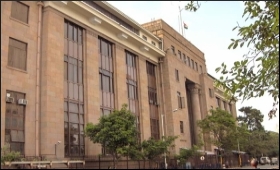|
|
|

|
IOB to seek PCA withdrawal after posting net profit: CEO
|
|

|
|
| Top Stories |
 |
|
|
|
SME Times News Bureau | 18 Feb, 2020
Indian Overseas Bank will approach Reserve Bank of India for withdrawal
of PCA (prompt corrective action) framework once it starts making net
profits even though the lender has already met the key criteria of below
6 per cent net NPA to be out of the restrictions, IOB Chairman Karnam
Sekar has said.
The longest serving PCA bank has drawn up
aggressive business plans on its focus areas -- Retail, Agri and MSMEs
where it is looking at higher disbursement targets and may tap market if
there is a need for capital on regulatory front.
The government
recently infused Rs 4,360 crore in the bank. The bank is not part of
any merger scheme announced by the government last year.
"We
hope to make net profit from this quarter (January-March) onwards and
then we will approach government and RBI for PCA withdrawal. We have a
below 6 per cent net NPA already and we want to observe it for more
quarter to prove that it is sustainable," Sekar told IANS in an
interview.
As of December 2019 quarter, the bank's Net NPA fell
to 5.81 per cent. PCA withdrawal benchmark mandates below 6 per cent Net
NPA. IOB reported a standalone loss of Rs 6,075.49 crore for the
quarter ended December 31 as provisions jump three times.
The
public sector lender had posted a loss of Rs 346.02 crore in the same
period last year. He said the bank does not currently need either
regulatory or growth capital but may tap market if there is a need.
"We
may fall short slightly on CRAR including the counter cyclical buffer.
After we hopefully make profits in this quarter capital adequacy ratio
will be comfortable. We don't need growth capital also since our plans
are not very aggressive immediately. If at all we need, we will go for
Tier 1 or Tier 2 capital from market", the CEO said.
Capital to
Risk (Weighted) Assets Ratio (CRAR) is also known as Capital adequacy
Ratio, the ratio of a bank's capital to its risk. IOB is in PCA for the
last 5 years, longest stay for any commercial bank under PCA because of
heavy exposure in corporate loans bringing huge NPAs. Government so far
has infused about Rs 8000 crore capital.
"We will not go big on
corporate sector because of our high NPAs. We will have overall 1.5-2
per centr loans of overall loan book not beyond it in corporate
portfolio. We will try to focus on MSME and retail loans. Across our
3000 branches we have a MSME portfolio of Rs 31000 crore, we want to
increase it to at least Rs 50,000 crore over the next two years. Its a
portfolio we will nurture and grow as a strategy. The bank has an
overall portfolio of a little over Rs 1 lakh crore in RAM portfoilo",
Sekar said.
He said the bank is trying to bring corporate
slippage to zero and RAM portfolio slippage to 2 per cent from the 4 per
cent earlier, then additional provisioning will reduce. IOB's NPA's
provision coverage ratio is 86 per cent now and net NPA is Rs 7,000
crore in absolute amount.
On its net profit possibilities, the
CEO said, "We are making operating profit in the range of Rs 800 crore
each quarter. We are recovering about Rs 200 crore each quarter from
written-off accounts, which directly adds to the operating profit which
is Rs 3000 crore operating profit annually".
As per IOB's
strategy to post profit, he said, "Last several years the bank had to
make huge provisions on credit which has led to an accumulated provision
of Rs 43,000 crore. Not that the entire provision needed to be written
off or to be absorbed, as and when we recover NPAs some of them will be
ploughed back which will be straight addition to operating profit".
|
|
|
| |
|
|
|
|
|
|
|
|
|
|
|
|
|
|
| |
| Customs Exchange Rates |
| Currency |
Import |
Export |
US Dollar
|
₹88.70
|
₹87 |
UK Pound
|
₹119.90
|
₹116 |
Euro
|
₹104.25
|
₹100.65 |
| Japanese
Yen |
₹59.20 |
₹57.30 |
| As on 30 Oct, 2025 |
|
|
| Daily Poll |
 |
 |
| Who do you think will benefit more from the India - UK FTA in the long run?
|
|
|
|
|
|
| Commented Stories |
 |
|
|
|
|
|
| |
|